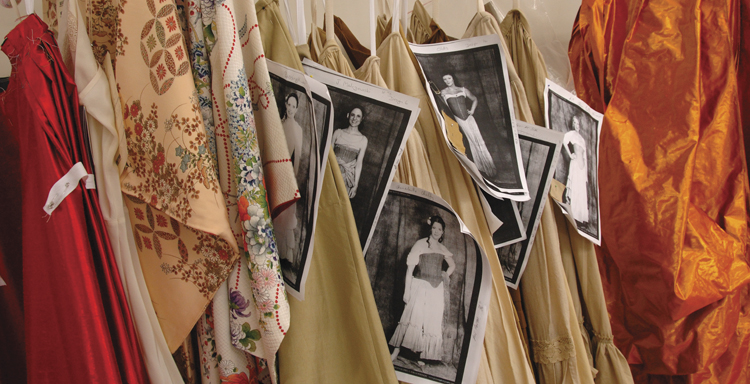Amid the relentless clatter of the sewing machines in the workshop, a slender woman is working flat-out. Lyn Heal, head of the Sydney Opera House wardrobe department, has a problem. One of the lead singers in The Barber of Seville has broken her arm and her plaster-cast won't fit the sleeve of her costume. Lyn now faces a race against time to draw up and complete a new outfit in three days flat. This isn't Lyn's first wardrobe emergency. This season has become a logistical nightmare with singers falling ill and costumes having to be rapidly redone to fit the back-up singers. It's these sudden constraints and accidents that make costume design a fast-paced world where there is absolutely no place for routine.
Fortunately, Lyn is well equipped for the challenge. After studying fashion manufacturing in Melbourne, she started working in the costume industry by chance and quickly decided to make it her career. She prefers making stage costumes due to the far greater scope it offers than ready-to-wear fashion. Whereas a typical fashion designer might focus on two seasons each year, Lyn must create clothes for 25 different shows. The Sydney Opera House wardrobe department often has to juggle several production deadlines at the same time, so forward-planning is essential.
About 12 months before an opera's premiere, the first costume sketches are presented to Lyn who immediately establishes a budget. A buyer is then responsible for sourcing all the various fabrics. 70 per cent of the materials come from India. Sketches then whiz back and forth between the designer and the wardrobe department's technical staff, before the making of the costumes begins six months ahead of the opening night.
But good organisation isn't the only challenge. Ensuring the durability of garments is also a prime concern. A costume must last for 10-15 years and also be able to withstand being washed countless times while still being comfortable enough not to restrict the artist's performance. Moreover, the wardrobe staff requires numerous tricks to fix technical problems such as quick costume changes or complicated special effects. At the moment, Lyn is racking her brain about how to create a unique type of hat. When the character bends his head, a downpour must spill out from the hat. "I need to find a way to store water in the hat while the singer acts" she says. "Not that easy!"
Often these technical demands conflict with the designer's aesthetic vision. "It is sometimes frustrating," designer Leon Krasenstein admits. "But it is part of the game." The 24-year-old instead finds an outlet for his artistic inclinations by embellishing a costume's details - like embroidering the finish of a buttonhole for example. For Leon, the most vital part of the process is the fitting session with the performer. The costumes are the all-important finishing touch that allow a singer to really enter a character's skin. Zofia Wysocki has worked as a tailor in the Opera House's wardrobe department for the last 20 years and this is the second time she's worked on The Barber of Seville. But a new production means an entirely fresh interpretation and strikingly different costumes. Today, she's making a maid outfit for which the director wants to mix Spanish influences with a 1930s twist. Zofia constantly refers to a style guide on her table to avoid any anachronisms. Around her, other tailors are bringing to life Charleston dancers, flamenco ballerinas and elegant aristocrats under the sharp needles of their sewing machines.
Creating accurate costumes requires a good knowledge of history as well as artistic flair. The Barber of Seville outfits include numerous references to the surrealist movement and particularly the works of Spanish painter, Salvador Dali. Alone in his bric-à-brac workshop, Sam Jelinek is responsible for making all the accessories. For the last four hours he's been making a life-size pig's eye brooch to hook onto the collar of a coat - a cheeky reference to the famous scene in the movie Un Chien Andalou by Büel and Dali where an eyeball is sliced with a razor blade. Sam sits surrounded by shelves covered with boxes crammed full of military medals, golden shoe-buckles, lace fans and gimcrack, shimmering jewels. The workshop feels like a treasure cavern from the Arabian Nights. "Baroque, classical, contemporary, it is always different!" he says of the different historical periods he must reflect in his work. "I am never bored!"
Above the tailoring workshops hangs the millinery section. On the shelves sits an identity parade of faceless plastic heads with perfectly sculpted hairstyles. Emma Theobald, a wig-maker at the Opera House for three years, is renovating a damaged wig with strands of human hair. It's a painstaking process as each hair must be sewed on one-by-one - a single centimetre-wide strip of hair on the front of the wig will take eight entire hours to complete. Once this laborious task is done, the dummy's head goes into the hands of the hairdresser, Toni Paul, so the wig can be combed into the right historical style. As she swaps between rollers, extensions and curling irons, it feels like a real hair salon. "The sensation of touch is exactly the same as on a real person," insists Toni, before adding with an amused smile: "But at least, there is no need to make small talk!"
